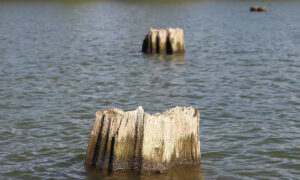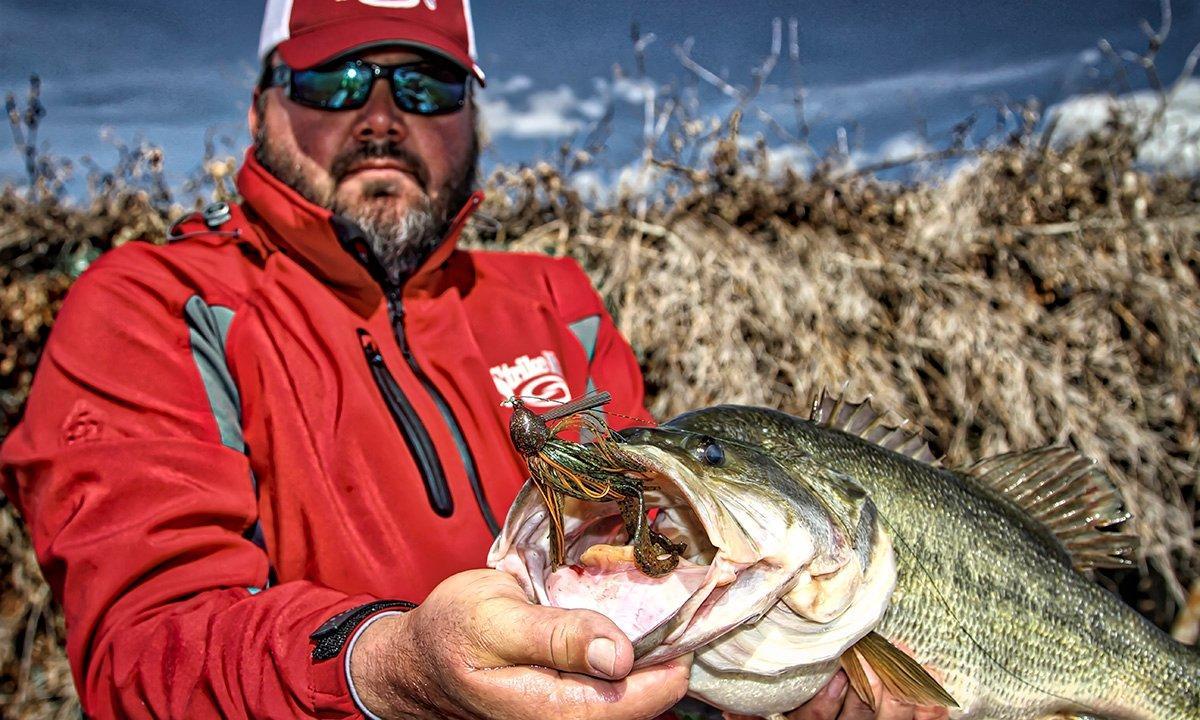In waters lacking deep offshore ranges, bass often turn to wood cover for their winter warmth. This makes targeting isolated wood in the winter a great bass fishing pattern. This is particularly applicable during the dreaded post-frontal “bluebird” conditions, when bass hug the cover and become predictable targets.
Laydowns, logs, stumps and standing timber all offer bass not only warmth, but also necessary feeding areas. Bassmaster Elite Series pro Terry Scroggins favors hydrilla mats in southern bowl type lakes, but where the grass is sparse, he’ll go looking for fish around wood cover.
“Flood waters from tropical storms can bring a lot of current, and you can get behind those trees and use them for a current break,” he said. “When those fish are back there to get out of the current, you can flip a jig or throw a spinnerbait or a square bill crankbait.”
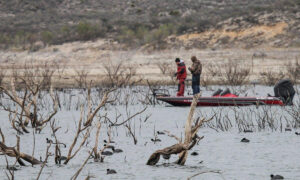
TARGET ACQUISITION
During the chilly months, Texas guide Stephen Johnston won’t waste time trying to fish every piece of wood available. Rather, The biggest piece of wood on a given bank will hold the greatest attraction. Not that smaller laydowns, logs, etc. won’t attract fish, but the larger the object, the more heat it holds.
“If you have a bank that doesn’t have a lot of (fallen) wood, the fish are going to get on two or three trees that are grouped together and hunker right against the side of them,” Johnston said. “They’ll back up against it almost like a ledge because that wood will hold some heat. The water temperature will be warmer against the larger wood than just a little piece.”
California pro Ken Mah agrees and notes that isolated wood with quick access to deep water holds high potential in his book.
“I love fishing wood in the winter especially on south facing banks,” Mah said. “The sun moves to the south in the winter so south facing banks get the most sun and are protected from cold north winds.”
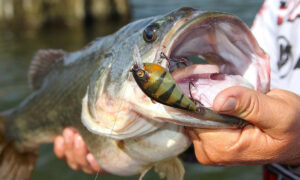
BAIT CHOICES
Johnston likes bumping his way around with a squarebill crankbait, but if the water is super cold, he knows he needs a creeping presentation with a 3/8-ounce jig with a piece of pork rind or a big trailer to offer a slower fall.
“In the winter, when the fish’s metabolism slows, you want something that’s not as active,” he said. “You want something that will fall right there in their face.”
Mah likes flipping/pitching winter wood with 1/4- to 3/8-ounce black and blue jigs with Big Bite Baits chunk trailers. Line choice is key for this deal. He’ll use fluorocarbon around old wood because it doesn’t dig in like braid.
Johnston will throw a 3/8-ounce spinnerbait into a laydown, reel it slowly until he makes contact with a limb and then kill the bait. Once it falls to the bottom, he’ll reel slowly to bring it out at a creeping pace.
Mah, too, likes a spinnerbait’s wood appeal. He’ll go with a single Colorado blade for maximum fish-calling thump and crawl it through the cover.
Mah’s other option for winter wood is a light Texas-rigged tube. He likes black and blue here, as well, but shad colors and black/white laminate also produce.
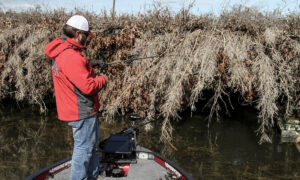
POSITIONING TIPS
Laydowns: Johnston warns against wasting time fishing behind where the fish are actually sitting.
“The biggest key is to fish the end of the laydown,” he said. “A lot of people throw at what they see, but they never think about what’s at the very end.
“If you have a big laydown and the main trunk is in the water, you want to cast your bait toward the end that’s near the deepest water. Even though you can’t see it, the better cover is there.”
Standind timber: When targeting standing timber in the winter months, Johnston looks for the biggest he can find. Same logic as that sizeable shoreline wood – more mass equals more heat retention.
“On a lot of the pine trees, the limbs have rotted off, so it’s almost like a toothpick,” Johnston said. “But if you can find something like a sweet gum tree or an oak tree, you’ll have some limbs sticking off that stump down there.”
Also note that water temperature will determine the depth at which fish will position on the standing timber – much like their vertical movements along bluff walls. Johnston advises astute attention to bites and depth, as this establishes the zone of consistency for those squarebills, spinnerbaits and Texas rigs.
Creek channel swings: Creeks lined with hardwoods and heavy brush also present winter options. After the fall feeding runs, the fish leave the creeks and position on the outer edges near the main lake.
General bait mix here might include spinnerbaits, squarebills, jigs and jerkbaits.
Duck blinds: Elite pro Greg Hackney knows that a duck blind with deep water nearby can be on overlooked gold mine. He pitches jigs or Texas-rigged worms and creature baits around the edges and into the openings.
Stump Fields: Here, again, water depth is key; both in terms of proximity to deeper areas and the varying internal depth. Stump fields with comfortable depths find bass huddling next to nature’s space heaters.
“It’s like the deer when their out of the rut, they get in the heaviest thicket they can find,” Johnston said. “I think it’s the same with bass. When the water gets cold, they look for the warmest cover they can find.”
Johnston generally works a stump field by covering water with a squarebill until he establishes an area of consistency. Once he dials in a target zone, he’ll pick it apart with a jig.
“There will be something in that stump field that holds them,” he said. “It might be one bigger stump or it might be a 2-foot slough that runs through there.
“I always say: one bite is an accident; two bites pay attention; three bites, and now you’re on to something.”
